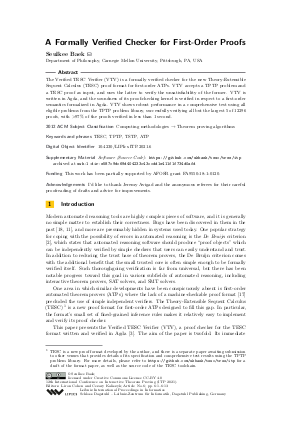A Formally Verified Checker for First-Order Proofs
Author Seulkee Baek
-
Part of:
Volume:
12th International Conference on Interactive Theorem Proving (ITP 2021)
Part of: Series: Leibniz International Proceedings in Informatics (LIPIcs)
Part of: Conference: International Conference on Interactive Theorem Proving (ITP) - License:
 Creative Commons Attribution 4.0 International license
Creative Commons Attribution 4.0 International license
- Publication Date: 2021-06-21
File

PDF
LIPIcs.ITP.2021.6.pdf
- Filesize: 0.64 MB
- 13 pages
Document Identifiers
Subject Classification
ACM Subject Classification
- Computing methodologies → Theorem proving algorithms
Keywords
- TESC
- TPTP
- TSTP
- ATP
Metrics
- Access Statistics
-
Total Accesses (updated on a weekly basis)
0Document
0Metadata
Abstract
The Verified TESC Verifier (VTV) is a formally verified checker for the new Theory-Extensible Sequent Calculus (TESC) proof format for first-order ATPs. VTV accepts a TPTP problem and a TESC proof as input, and uses the latter to verify the unsatisfiability of the former. VTV is written in Agda, and the soundness of its proof-checking kernel is verified in respect to a first-order semantics formalized in Agda. VTV shows robust performance in a comprehensive test using all eligible problems from the TPTP problem library, successfully verifying all but the largest 5 of 12296 proofs, with >97% of the proofs verified in less than 1 second.
Cite As Get BibTex
Seulkee Baek. A Formally Verified Checker for First-Order Proofs. In 12th International Conference on Interactive Theorem Proving (ITP 2021). Leibniz International Proceedings in Informatics (LIPIcs), Volume 193, pp. 6:1-6:13, Schloss Dagstuhl – Leibniz-Zentrum für Informatik (2021)
https://doi.org/10.4230/LIPIcs.ITP.2021.6
BibTex
@InProceedings{baek:LIPIcs.ITP.2021.6,
author = {Baek, Seulkee},
title = {{A Formally Verified Checker for First-Order Proofs}},
booktitle = {12th International Conference on Interactive Theorem Proving (ITP 2021)},
pages = {6:1--6:13},
series = {Leibniz International Proceedings in Informatics (LIPIcs)},
ISBN = {978-3-95977-188-7},
ISSN = {1868-8969},
year = {2021},
volume = {193},
editor = {Cohen, Liron and Kaliszyk, Cezary},
publisher = {Schloss Dagstuhl -- Leibniz-Zentrum f{\"u}r Informatik},
address = {Dagstuhl, Germany},
URL = {https://drops.dagstuhl.de/entities/document/10.4230/LIPIcs.ITP.2021.6},
URN = {urn:nbn:de:0030-drops-139010},
doi = {10.4230/LIPIcs.ITP.2021.6},
annote = {Keywords: TESC, TPTP, TSTP, ATP}
}
Author Details
Funding
This work has been partially supported by AFOSR grant FA9550-18-1-0120.
Acknowledgements
I'd like to thank Jeremy Avigad and the anonymous referees for their careful proofreading of drafts and advice for improvements.
Supplementary Materials
-
Software (Source Code)
https://github.com/skbaek/tesc/tree/itp
browse
 archived version
archived version
References
-
Michaël Armand, Germain Faure, Benjamin Grégoire, Chantal Keller, Laurent Théry, and Benjamin Werner. A modular integration of sat/smt solvers to coq through proof witnesses. In International Conference on Certified Programs and Proofs, pages 135-150. Springer, 2011.

-
Henk Barendregt and Freek Wiedijk. The challenge of computer mathematics. Philosophical Transactions of the Royal Society A: Mathematical, Physical and Engineering Sciences, 363(1835):2351-2375, 2005.

-
Ana Bove, Peter Dybjer, and Ulf Norell. A brief overview of agda-a functional language with dependent types. In International Conference on Theorem Proving in Higher Order Logics, pages 73-78. Springer, 2009.

-
Mario Carneiro. Metamath zero: The cartesian theorem prover. arXiv preprint arXiv:1910.10703, 2019.

-
Zakaria Chihani, Tomer Libal, and Giselle Reis. The proof certifier checkers. In International Conference on Automated Reasoning with Analytic Tableaux and Related Methods, pages 201-210. Springer, 2015.

-
Luís Cruz-Filipe, Marijn JH Heule, Warren A Hunt, Matt Kaufmann, and Peter Schneider-Kamp. Efficient certified rat verification. In International Conference on Automated Deduction, pages 220-236. Springer, 2017.

-
Luís Cruz-Filipe, Joao Marques-Silva, and Peter Schneider-Kamp. Efficient certified resolution proof checking. In International Conference on Tools and Algorithms for the Construction and Analysis of Systems, pages 118-135. Springer, 2017.

-
Jared Davis and Magnus O Myreen. The reflective milawa theorem prover is sound (down to the machine code that runs it). Journal of Automated Reasoning, 55(2):117-183, 2015.

-
Nicolaas Govert De Bruijn. Lambda calculus notation with nameless dummies, a tool for automatic formula manipulation, with application to the church-rosser theorem. In Indagationes Mathematicae (Proceedings), volume 75, pages 381-392. North-Holland, 1972.

-
Kurt Gödel. Über formal unentscheidbare sätze der principia mathematica und verwandter systeme i. Monatshefte für mathematik und physik, 38(1):173-198, 1931.

-
John Harrison. Towards self-verification of hol light. In International Joint Conference on Automated Reasoning, pages 177-191. Springer, 2006.

-
Marijn Heule, Warren Hunt, Matt Kaufmann, and Nathan Wetzler. Efficient, verified checking of propositional proofs. In International Conference on Interactive Theorem Proving, pages 269-284. Springer, 2017.

-
Marijn JH Heule, Warren A Hunt, and Nathan Wetzler. Verifying refutations with extended resolution. In International Conference on Automated Deduction, pages 345-359. Springer, 2013.

-
Marijn JH Heule, Warren A Hunt Jr, and Nathan Wetzler. Bridging the gap between easy generation and efficient verification of unsatisfiability proofs. Software Testing, Verification and Reliability, 24(8):593-607, 2014.

-
Ramana Kumar, Rob Arthan, Magnus O Myreen, and Scott Owens. Hol with definitions: Semantics, soundness, and a verified implementation. In International Conference on Interactive Theorem Proving, pages 308-324. Springer, 2014.

-
William McCune and Olga Shumsky. Ivy: A preprocessor and proof checker for first-order logic. In Computer-Aided reasoning, pages 265-281. Springer, 2000.

-
Giles Reger and Martin Suda. Checkable proofs for first-order theorem proving. In ARCADE@ CADE, pages 55-63, 2017.

-
Giles Reger, Martin Suda, and Andrei Voronkov. Testing a saturation-based theorem prover: Experiences and challenges. In International Conference on Tests and Proofs, pages 152-161. Springer, 2017.

-
Alexandre Riazanov and Andrei Voronkov. The design and implementation of vampire. AI communications, 15(2, 3):91-110, 2002.

-
Stephan Schulz. E-a brainiac theorem prover. Ai Communications, 15(2, 3):111-126, 2002.

-
Raymond M Smullyan. First-order logic. Courier Corporation, 1995.

-
Geoff Sutcliffe. Semantic derivation verification: Techniques and implementation. International Journal on Artificial Intelligence Tools, 15(06):1053-1070, 2006.

-
Geoff Sutcliffe. The TPTP problem library and associated infrastructure. Journal of Automated Reasoning, 43(4):337, 2009.

